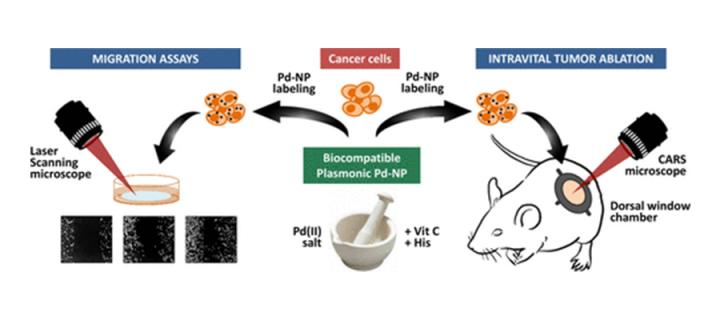Killing cancer cells using palladium nanoparticles
Cancer Research UK Edinburgh Centre scientists develop a scalable method for preparing palladium nanoparticles suitable for the phothothermal ablation of cancer cells: February 2018

Photothermal therapy (PTT) is a newly developed and encouraging therapeutic strategy, which employs electromagnetic radiation (most often in infrared wavelengths) to generate heat for the thermal ablation of cancer cells exposed to near-infrared laser irradiation. Compared with the conventional therapeutic treatments (modalities), PTT offers unique advantages in cancer therapy, including high specificity, minimal invasiveness and precise spatial-temporal selectivity.
PTT can directly eradicate the cancer cells in the primary tumour or in the local metastasis in lymph nodes to combat the initial stage of cancer metastasis. It can also be combined with other therapeutic modalities to treat cancer cells in the metastatic sites. There is significant interest in the development of new types of photothermal nanotherapeutics and Cancer Research UK Edinburgh Centre scientists are very active in this field.
In a recent study “High-Precision Photothermal Ablation Using Biocompatible Palladium Nanoparticles and Laser Scanning Microscopy”, published in the journal ACS Applied Materials & Interfaces, the research team led by Dr Asier Unciti-Broceta from the CRUK Edinburgh Centre reported a straightforward, scalable method to prepare palladium nanoparticles displaying high biocompatibility and photothermal efficacy.
These nanoparticles enter cancer cells with high efficiency, remain in the cell cytoplasm without causing direct cell damage, and induce thermal ablation under harmless near-infrared laser irradiation. For the first time, these researchers also showed ablation and simultaneous imaging of palladium-nanoparticle-labelled cells using coherent Raman microscopy. This important work has implications for future developments in the field of photothermal therapy and may lead to new types of cancer therapeutics.
Links
Article in ACS Applied Materials & Interfaces

